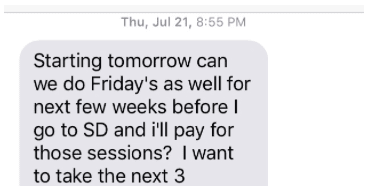One thing that I've learned in the fitness industry is that there is no right way to do things. Say it with me: There’s no right training method, exercise, or diet.
Yet there’s always a group of people who hold steadfastly to their beliefs and try to hit other people over the head with them. Among these hotly debated topics is the idea of offering gratis training: Should you train for free to attract clients, or is that de-valuing your time and abilities?
This is a decision that confounds personal trainers. New trainers, in particular, may consider this since they haven’t yet built a stable roster of clients or established their credibility. Further, just because they have a simple certification doesn’t mean they know anything. The fact is, no personal trainer should be “above” training a client or working for free. In fact, even the best trainers among us have admitted to giving complimentary coaching at some point in their career.
Take John Romaniello, for example. He’s trained people for free in the beginning to fill his roster and get his “reps” in for coaching. Mike Vacanti was able to train celebrity entrepreneur Gary Vaynerchuk because Vacanti had worked with Romaniello for free. I remember reading an email from Jordan Syatt that he used to train people for free when he started online coaching as well.
All of the previous examples simply mean that free coaching isn’t always a waste of your time.
3 major benefits when you train for free
Free coaching can be extremely beneficial, when structured properly. That said, if you’re considering free coaching, here are some key benefits to consider:
Benefit #1: It builds confidence in you
One of the things that many new personal trainers lack is the confidence to get a client results, every time. Building that confidence is important for the long term. You can always make more money, because when you’re good at what you do, money often is much easier to come by. But building confidence takes much more effort.
Confidence comes from knowing that your skills, methods, thinking, and general coaching can bring results.
And you only know that by putting in the hours for more experience, sometimes for free. You’ll be able to test out different training methods that you might’ve learned over the years or read about. For example, you might find the principles of “5/3/1” interesting, but you’d like to see whether that or Bret Contreras’ 2x4 program might be better for your clients.
You can read all of the supposedly best cues, but if you don’t know how or when to use which cue for each client, or be able to teach your client how to perform certain movements, your coaching cannot live up to its potential, plain and simple.
As you see your free clients get results from your efforts, you won’t have to go into future sales meetings thinking, Could I actually get this person results? Instead, you think, Hot dang, you’ll get your results and then some!

That confidence alone is worth much more than the 300-600 dollars you may get for training that person for a month.
READ ALSO: How to Build Your Personal Training Client Roster Fast
Benefit #2: You find out the type of clients you like to work with
When you’re just starting out, you probably don’t know whom exactly you want to work with. You just know you want to help.
Maybe initially you wanted to work with clients to help them lose fat, but find that you enjoy helping people rehabilitate injuries instead. When you train people for free, you end up getting a sample of everything. You wouldn’t have necessarily known that if you hadn’t trained a while for free. When you work with different types of clients, you are able to better narrow down your niche, as PTDC’s head coach, Jon Goodman, and other writers talk about frequently.
Benefit #3: You have the opportunity to build more connections
As you work with more people, you may eventually run into people who are highly influential. Maybe the client you choose to train for free is someone who has connections to many of your ideal clients. There is a good chance this same client may also sign on as a full-time client.
All in all, we can agree that free training can help your career along, but let’s next discuss how you can leverage your expertise intelligently.
3 ways to maximize your time and potential of free training sessions
In the beginning, I was in the “free training devalues my time” camp, as I begrudgingly trained a few clients for free. Now I see free training sessions as strategic opportunities to expand my business. In other words, you can’t just give people free training willy-nilly. Instead, here’s what you do.
1. Pick clients who are similar to you
If you try to help everyone, you end up helping no one. Be more selective. So start with helping those who share a similar story to your own.
Maybe you started training to get better at basketball. If that’s the case, approach those who want to boost their basketball game and offer to train for free. Or, maybe you’ve had an incredible weight loss transformation that gave you a brand new life. If so, take on clients who want to lose weight as well.
By sticking with clients you know how to train (because you’ve been through the same journey), you increase the likelihood of getting more paying clients and expanding your reach as “that trainer” who does a specific thing. From there, you can keep growing.
But first, focus on what you’re good at. When you promote your free training on Facebook or Instagram, start by reaching out to your own friends list.
Try this: Add in a great photo of you training (not just a selfie). For your photo’s description, you might say something like:
Since I have recently started personal training, I want to offer three people a one-month personal training package valued at X dollars. If you are finally ready to master your fitness, put ‘Sign me up!’ in the comment section and I’ll pick the three winners tomorrow evening.
If your friends aren’t interested, join different groups (with your target client) and start by providing helpful tips and lots of value. Don’t just sell right away. Make yourself useful. Share useful articles or maybe even your own client’s victories, if applicable. For example, if you want to work with new moms, join the group and post actively, responding to questions and generally giving help.
2. Change your mindset of a “free training service”
When you train clients for free, there’s the slippery slope of neglecting to place a value on your time and services. First, even though you may be training for free, you must respect your time. In that spirit, I recommend limiting your free sessions to a maximum of three people per week.
We often deliver a service that is commensurate with the session’s value. So, at zero dollars, we (perhaps unknowingly) deliver the type of service that is worth zero dollars. The client isn’t dumb. They will feel this, and if that’s the case, you will not get their business or any clients’.
This is where you need to change your perception about the free training session.
Perceive every hour of training as equally worthy of your typical session fee--whatever it may be. Think, If this person were paying my full session fee, how could I exceed even that expectation? You must hold yourself to that high standard and provide that experience.

When you think this way, you give your client a much better service and they will see and appreciate it. If they see the quality of your service and results, they will either want to pay you to continue or refer you a friend who needs your service (or both).
By creating monetary and time boundaries, you let your future client know you value what you offer and that they should too.
3. Don't actually make your training 100% free
Doing something for free is nice, but it ultimately doesn’t make for a fulfilling career, financially speaking.
Don’t think of your free service as 100% free. Instead, ask your new client to refer you to three of her friends who she thinks would be a good fit. Here’s something you could say at the start:
Hi Darlene. I’m glad to start training with you. In exchange for the training we will be doing, I am hoping for you to think of three friends who you think would be a great fit for personal training. I’ll ask you again in one month, but if you could start thinking of three women age 50-60 who want to get in better shape to keep up with their grandkids, I would greatly appreciate it!
Give the best dang personal training service you can provide and impress your client, and at the end, follow it up with:
Darlene! I’ve had a great time training with you, and I’m so happy to see the progress you have made. Do you have the contact info of three people you think would be a great fit? Would they mind if I contacted them to talk about training?
If Darlene has been happy with your service, she may happily provide the names of three people. Great! But you need to take your steps carefully from here.
First, thank Darlene, your client, for the referrals with a thank you card and a small gift. Don’t forget your current clients! Try to avoid offering more free sessions. Your gift here is a chance to establish rapport and make you memorable. On the thank you card, you can write:
Darlene, I want to give a big thank you for mentioning my name to your friends. I really appreciate it, as word of mouth is one of the greatest forms of new business. Please accept this gift as my way of saying thanks. I look forward to the progress you make going forward.
Now you have to follow up with the three friends. Reach out to them with this script:
Hi there! My name is _____, and I’m ______’s personal trainer. She told me you were very interested in seeing what this personal training is all about, so do you have time this week for a short meet and greet? I’d love to hear your thoughts and why you’re wanting personal training... See you at our meeting!
From there, you get someone in the door and let the general consultation and savvy closing techniques drive the sale.
Doing this will ensure you have a solid list of leads you can capitalize on later (check this great referral script on the PTDC for that). If you truly have a great service, it will be a no-brainer for them to recommend their friends.
Additionally, I want to show you that converting a free client to a paying client can be done. This is a real text message I got from one of the clients I trained for free:

It started with him purchasing four extra sessions, after which he committed to the next six months as a paying client.
Just remember: we are not above working for free in the beginning.
Sure, free training can be a time suck if done without a strategy. But if you are able to place a cap on the amount of time dedicated to this and add value to it, this can be a valuable way to gain leads. More importantly, the extra experience builds the kind of confidence that propels a young personal trainer toward a fulfilling career of personal training.









